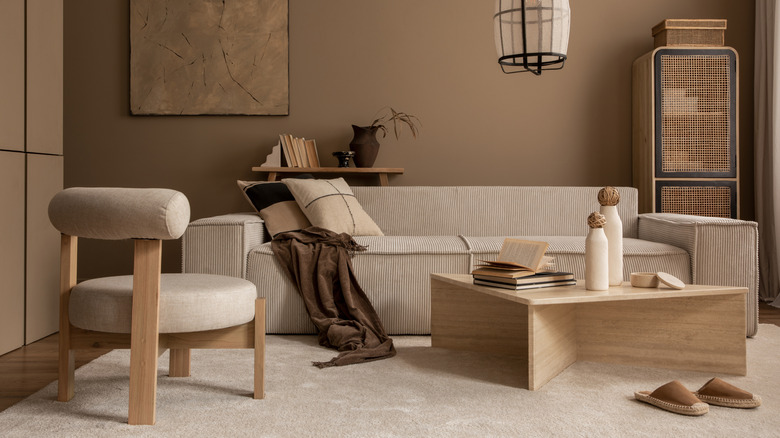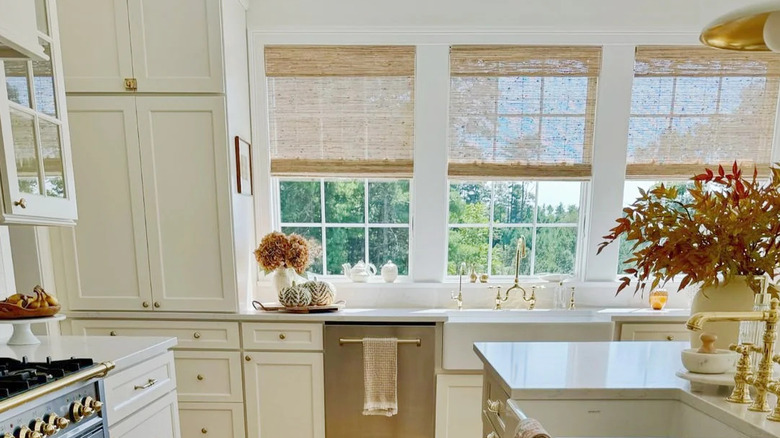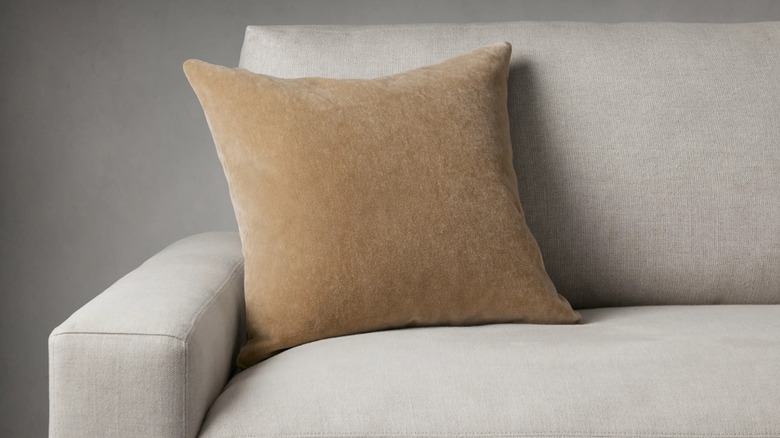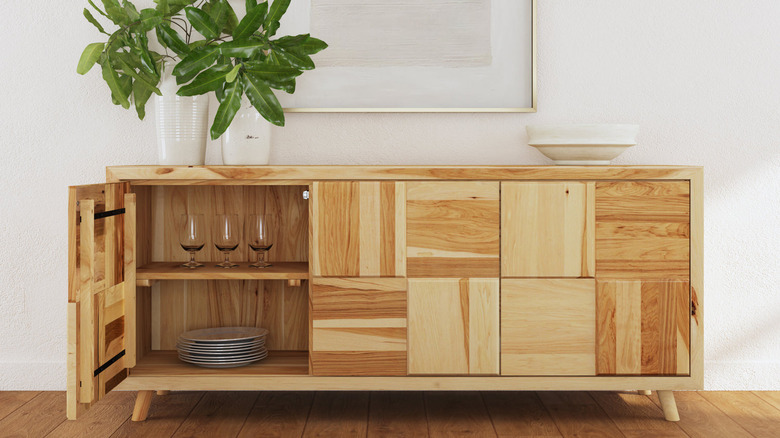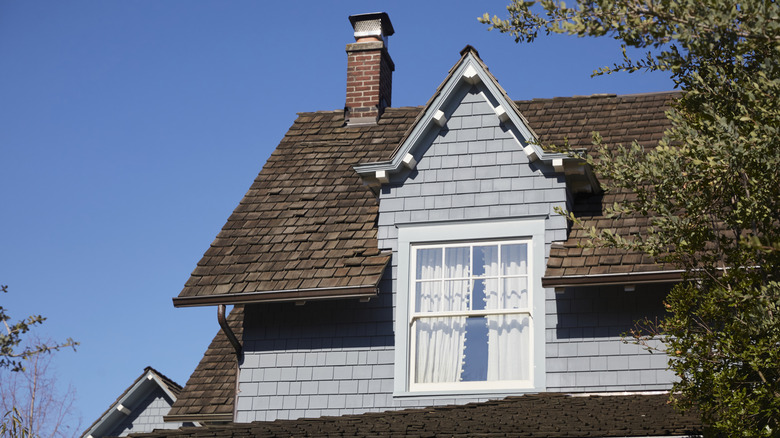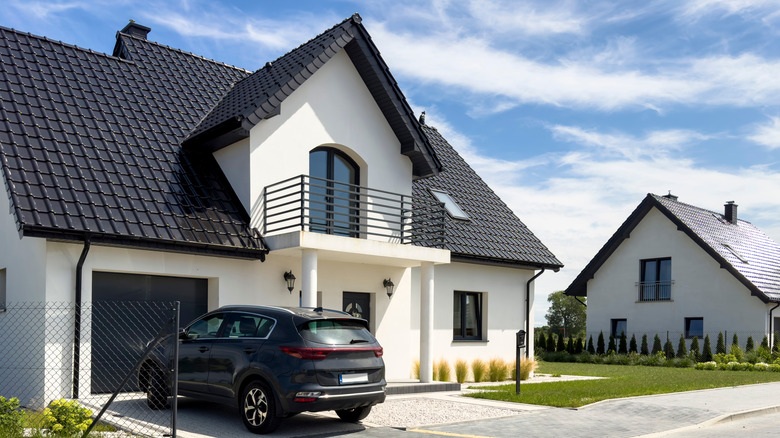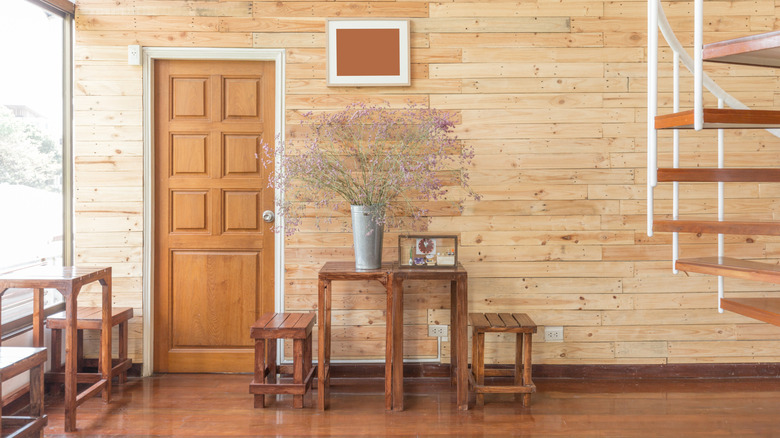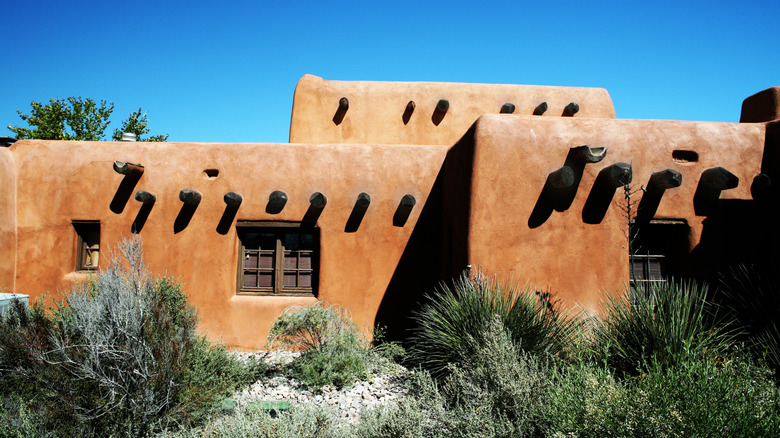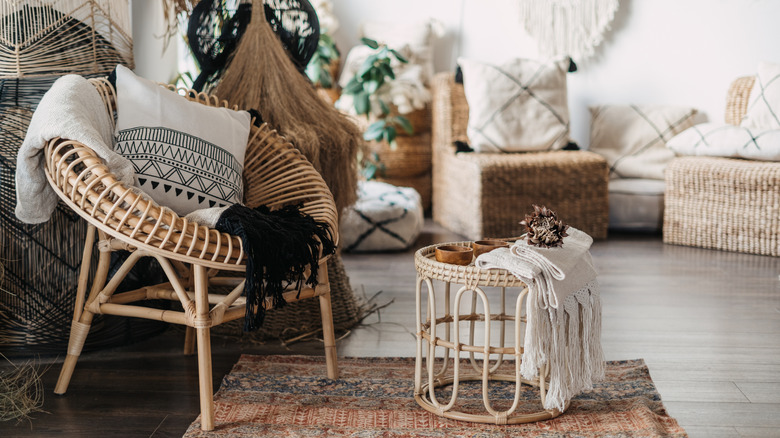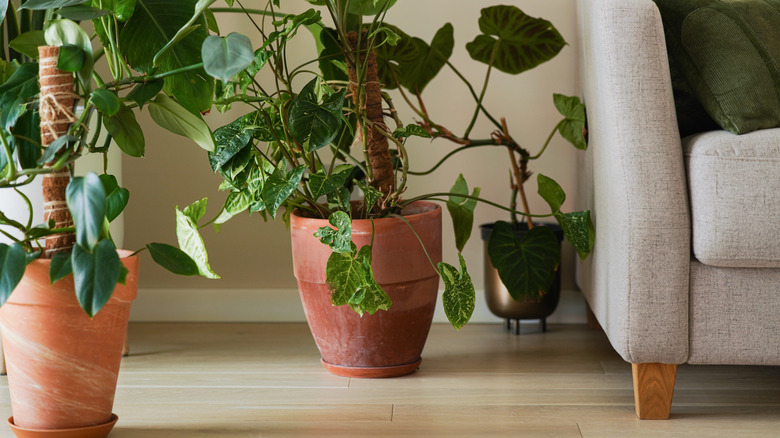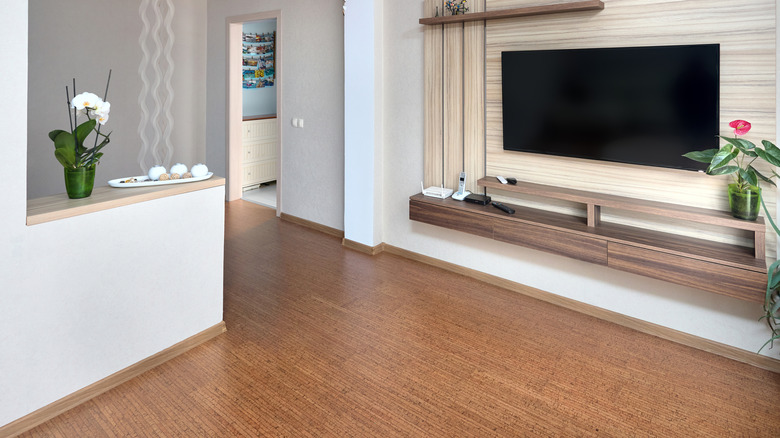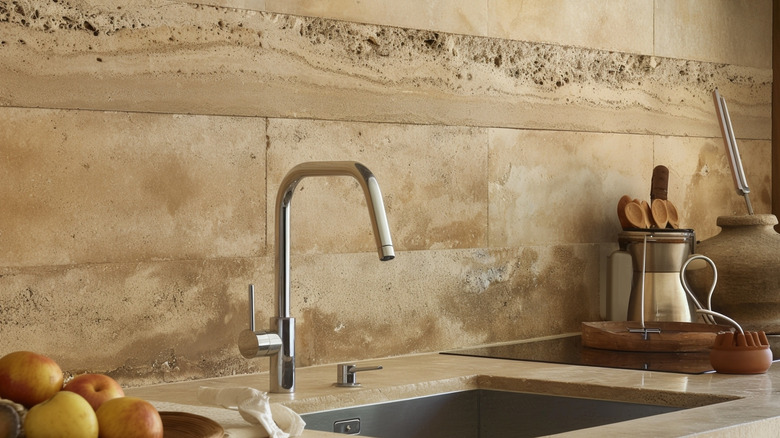Trendy Natural Materials You'll Be Seeing More Of In Homes Everywhere
If you have scrolled through Instagram or taken a look at the newest collections at home goods stores, you might have noticed more and more natural materials on display. Things like travertine trays, carved marble knick-knacks, raw wood bowls, and steel-framed mirrors have been dominating popular stores. And, more and more photos on Pinterest and Instagram highlight rooms featuring wood paneling, marble pillars, and wrought iron accents. This move back to all things natural goes hand-in-hand with the recent biophilic trend, which brings the outside in. This design concept helps connect people with nature — a necessity in our increasingly digital world — and uses things found in the outdoors to do so, like plants, nature-inspired colors, and textures like stone, wood, and clay.
But which materials are trending the most right now? To help you make your home as on-the-pulse as possible, House Digest reached out to various home design experts to get their exclusive takes. From woven grass window treatments to stone veneer cladding, there are a lot of unexpected features making their way into the mainstream right now. Here's a closer look at how you can use these materials, whether you want to achieve a more organic aesthetic in your home or add a few earthy touches to a space.
Woven grass window treatments add warmth and filter light
When it comes to window treatments, you might not think you have many options. You can usually choose between wooden or plastic blinds, or canvas or cotton Roman shades. But there is a new style making its way into the mainstream, and that's woven grass window treatments. "I'm seeing a lot of treatments using grasses like ramie, which are great because they're renewable and can be sustainable cultivated," Portland-based interior designer, Max Humphrey, exclusively tells House Digest. This not only combines an earthy look, but it has the added bonus of being more eco-friendly.
To incorporate it into your own home, he suggests striking a balance with your decor. Meaning, you don't want to lean too heavily on one theme, as it can look too one-dimensional. "I like to play against type when it comes to natural materials; for example, using more rustic furniture in modern homes and modern materials in rustic homes," he says. So, if a room has a more contemporary feel, look for window treatments like Mood's Custom Bamboo Shades that come in a variety of colors and can bring warmth to the space.
Mohair provides a posh injection of texture
One way to elevate your space is by adding texture to your home decor. For instance, if you love an all-white room, enjoy the recent color-drenching trend, or just want a look that's dynamic and well-designed, then you need some texture to make it feel layered. You can utilize things like wool, leather, shag, velvet, and so on. But one interesting texture choice has been entering the conversation, and that's mohair. "I've also seen a lot of mohair, which is made from the fleece of goats," Humphrey explains. Its soft, almost unfocused appearance adds a touch of plushness to the room. And since mohair is often a luxury material, it also adds some elegance to the space.
The reason this has come into style is because it's a fresh alternative to velvet. "Velvet has been everywhere for a while, so mohair is a way to bring in an even more luxe element in upholstery options," he notes. It has that same softness and link to luxury but doesn't feel as common. This adds a fresh new element to your room and makes it feel "on trend" without being overly fad-oriented. To add subtle pops of the material, look for throw pillows like this one from Arhaus. Or, for a similar look at a lower cost, add this faux mohair version from Crate and Barrel to your pillowscape.
Hickory is an on-trend option for enduring wood furniture
Real wood furniture is a timeless home decor trend, and recently white oak and birch pieces have reigned supreme. However, there's now another wood edging its way into the mainstream, and that's hickory. "Hickory is a wood that's been used to make wood furniture, which has been popular in the national park lodges for over 100 years," Humphrey notes. However, it's not being used to create clunky, rustic dining tables or knot-heavy dressers. "I've been seeing it used in more contemporary ways by constructing more modern furniture shapes and experimenting with up-to-date finishes. Hickory is great because it's typically harvested from undergrowth so it's strong and sustainable."
This is likely trending due to those two reasons. Wood, but strong wood in particular, is more enticing since it acts as a backlash against all of the MDF and veneer furniture pieces on the market. Those pieces can splinter and break, but investing in something hickory feels more substantial. Compared to other wood options, hickory is an extremely durable choice for furniture. Rating over 1,800 on the Janka hardness scale, you can trust that your new pieces will stand up to the wear and tear of daily use.
To style it at home, Humphrey warns not to go too rustic with it and instead focus on balance. "If every decor element is a natural material, it might start feeling overly organic, so it's nice to bring industrial elements, like a hit of metal here and there," he shares. So, look for options that combine sleek elements with natural wood, like a hickory coffee table with matte metal legs, to create a stunning juxtaposition. Or, stick with pieces with clean lines like this sideboard from HOM Furniture for a more modern look.
Wood and slate shingles are re-emerging to elevate exteriors
The exterior of your house is also experiencing a shift in trends, particularly on the roof. While asphalt shingles are usually the norm, style-conscious houses are beginning to experiment with wood or slate shingles. However, these aren't new materials. History proves that these roofing materials can stand the test of time. For instance, slate shingles had their moment in the early 1900s, and became the predominant roofing material in the Northeast at that time. Cedar shingles, on the other hand, have been around since colonial times but became even more prevalent during the Victorian period. So, as styles cycle, both are seeing big moments when it comes to today's home exteriors.
"Wood and slate shingles are making a comeback due to their natural, eco-friendly feel. Wood provides warmth and slate offers an upscale, luxurious look," Peter Helton of HW Roofing exclusively tells House Digest. When it comes to upgrading your house with them, it's best to match the textures to particular styles. "I'd recommend wood for craftsman homes and slate for Victorian or Tudor styles," he shares. So, if you have a super-modern house, you might need to skip this type.
Metal roofs are trending for their sleek look
In addition to wooden and slate shingles, more and more homeowners are experimenting with metal roofs. They complement new builds especially since they're a great way to add a special detail to a modern house. "Metal roofs like copper and zinc are popular for modern farmhouses," Helton explains. As these home designs are moving away from being simple white and black designs and instead incorporating earthy elements like wooden posts and stone wall accents, a metal roof adds to that infusion of warmth and earthiness. "Either material would suit a minimal, contemporary space. For instance, I put a zinc roof on an open-concept beach house, complementing its sleek design."
One of the main reasons these roofs are trending is due to their sustainability. They last much longer than asphalt shingles — in fact, about twice as long. A well-maintained metal roof can last between 40 to 80 years, whereas regular shingles typically hang around for 20. While they cost more upfront, you won't have to think about replacing your roof for pretty much the rest of your life — which also means less waste is generated.
Reclaimed wood adds tons of character to a space
Reclaimed wood might have experienced a surge of popularity during the rise of modern farmhouse in the "Fixer Upper" era of the mid-2010s, but it's being incorporated in new and interesting ways a decade later. "It's eco-friendly and adds warmth," Pam Hutter, an award-winning sustainable architect and founder of Hutter Architects, tells House Digest. "I recommend reclaimed wood paneling for walls and ceilings and reclaimed wood or wood-look tile for floors."
"My design firm has used all of these materials in client homes this year," Hutter notes. She explains that wood is a material that can "create a calming, grounded space that provides reprieve from technology and busy lives." Plus, as current lifestyles have made many feel more and more disconnected from each other and nature, there is a focus on community and the planet. And as Hunter points out, "Sourcing reclaimed and sustainable materials supports local businesses and the environment."
But that's not the only lure. People are also embracing the character-rich material due to its past. "The beauty of reclaimed wood lies in its history and the fact that it's often salvaged from old buildings, giving it a distinctive patina," Veiko Kallas, the founder of JALG, shares. The interior designer also recommends the material for custom furniture in addition to accent walls explaining, "It brings a rustic, yet timeless feel to interiors, and its varied textures can add depth and interest to a room."
Adobe can create stunning, unique facades
There is another unexpected natural material trending for home exteriors, and that's adobe. Whereas most bricks are made from clay, adobe bricks are essentially made from mud. They're a mix of dirt, water, and a binder like straw or grass. While they've typically been a regional trend, they're now becoming more and more popular across the country. "In the past, it's been pretty limited to the Southwest especially, but I'm starting to see it even in more northern areas," Matt Balducci, Co-Owner and CEO of HomeHero Roofing, exclusively tells House Digest.
"I think this is just because it is a renewable material, and sustainability is pretty big on everyone's radar," he notes. Not only is it great for eco-conscious people building new construction, but it can also help with bills. "It's also great at temperature control and natural insulation, making it a good pick for plenty of different climates." However, that's not to say each person constructing an adobe house is worried about sustainability. Some might just be bored of the cookie-cutter style that social media has championed, and simply want to try something unexpected. "Plus, adobe homes just have a cool look that's hard to replicate with other materials, in my experience," he shares.
Bamboo marries airiness and durability
Bamboo is a material that's as versatile as it is eco-friendly. In fact, one of our experts credits concerns about deforestation and demand for sustainable materials for its rise in popularity. Vincent Larson, the Lead Interior Designer for sustainable product brand CopperSmith, explains, "Bamboo is having a real moment right now, and I think it's because of its fast-growing, renewable nature, making it one of the most eco-friendly materials available. As more people prioritize sustainability, bamboo has become a popular alternative to traditional woods."
The material works in many spaces within a home, allowing you to add a touch of nature everywhere from the kitchen to the bedroom. Larson explains, "Its versatility also adds to its appeal, you can use it for anything from flooring to furniture, window coverings, or even wall panels." The designer explains that the clean and airy look of bamboo, combined with its durability, makes it a great material for custom furniture that needs to stand up to heavy use like coffee tables and chairs. If you don't want to swap out your floors or commission a custom piece, this APRTAT Bamboo Bench allows you to add the material to your space in a budget-friendly and functional way.
Clay and terracotta are enduring earthy trends
If you're embracing the biophilic trend, then a great way to add some earthiness to your space is using clay or terracotta elements, whether that's as flooring, a backsplash, pottery, or planters. "Natural clay and terracotta are making a big comeback, especially in homes that value earthy, grounding elements," Larson explains. It not only adds warmth thanks to its natural pinkish-brown hue, but also a great amount of texture.
"I think part of the reason these materials are gaining traction is a reaction against the ultra-modern, sleek, and sterile interiors we've seen in recent years. People are craving more texture, warmth, and character in their spaces, and clay delivers just that," he notes. "Its raw, unrefined look feels authentic and handcrafted, which resonates with those who appreciate craftsmanship and organic design."
They're also easy to incorporate into most aesthetics. The soft red floor tiles are a staple for midcentury or '70s rooms, and can also add some warmth to the farmhouse look. The material blends seamlessly with the earthy cottagecore aesthetic and even has its place in minimalism if paired with simple furniture and a neutral palette. Plus, it works well in a variety of rooms. For example, D'vine's Terracotta Pot Set can add a boho vibe to your living room while Nourison's Table Lamp can add an earthy touch to your nightstand.
Cork elements add softness and texture
It may not be the most mainstream option, but cork flooring can be a great choice for your home. It brings a lot of rich texture to a room, is unexpected, and thus feels contemporary, and most importantly, it's sustainable. "The material is becoming more popular amongst the interior designers this year," Yosef Adde, an investor and real estate agent with I Buy LA, shares. He's seeing more of this material pop up in new builds, proving it's a very in-the-moment material. "The upshot of global warming has prompted many homeowners to look for eco-friendly substitutes, and thus cork whose extraction is purely renewable sources becomes a hot garnish. And, of course, the backlash against non-degradable, plastic materials has spurred it."
While it's currently popular as a flooring option, that's not the only way to use it. "These warm expanses of cork enhance the interior of any room with their insulation capabilities and can be used as wall coverings with added texture and sound absorption qualities," he notes. But if covering your walls and floors with the stuff is too much of a commitment for you, there are other ways you can weave it into your design. The real estate expert points out that the material is even being used to create store-bought items like furniture and accessories. You can add a subtle earthy vibe with accents like KFK Store's Cork Coaster Set. Or, create a fun statement with this cork side table from Wayfair.
Travertine is an on-trend, yet timeless, material
Adde also explains that travertine is a classic, natural material that's cycling back into new home designs. The real estate expert believes this is a rebellion from years of ultra-clean designs explaining, "With the market overwhelmed with synthetic and overly polished surfaces, more and more people are looking for travertine for its natural earthy colors and strength."
If you really love the look, you can use it for design elements in many rooms. "Travertine makes a perfect shower area wall finishing, used as walls for ovens, as kitchen backsplashes, and surfaces of the counters. The concentrated vein look and gentle colors give this stone a special soft finish adding beauty nevertheless does not dominate the space," Adde notes. And the best part is the stone is considered timeless, so it won't feel dated after a few years.
For a more accessible way to add it to your space, you can also find the material in everything from decor to furniture. For instance, retailers like Perigold offer small knick-knacks like the Collen Travertine Vase, whereas stores like CB2 have furniture like the Enyo Rectangular Travertine Coffee Table. These options make it possible for you to embrace the material's stunning, imperfect texture in a way that makes sense in your home.
